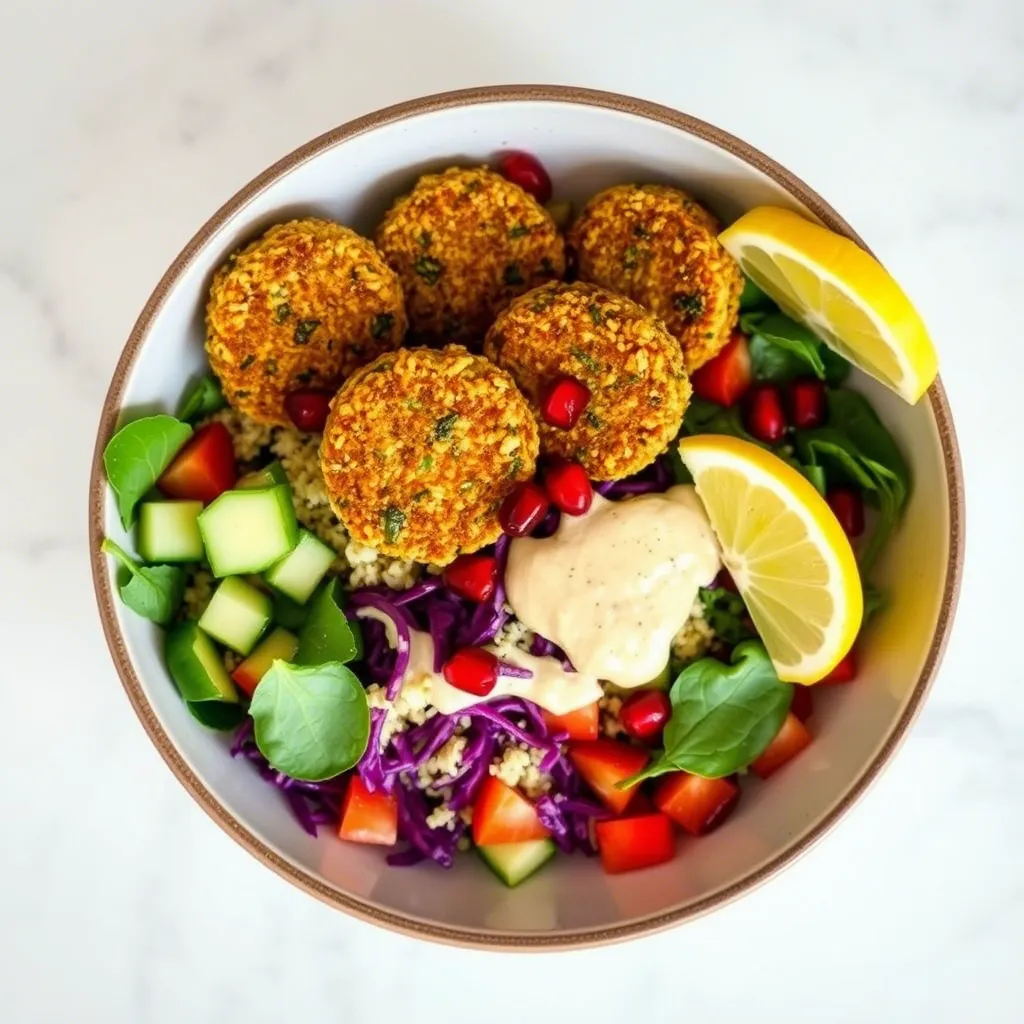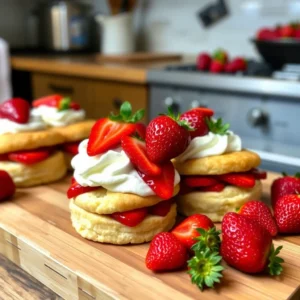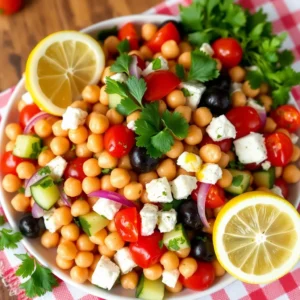Why You’ll Love These Crispy Baked Falafel Bowls
You know those evenings when you’re staring into your refrigerator, wondering how to put together something that’s not just another sad weeknight dinner? These baked falafel bowls are about to become your new best friend. As a busy parent myself, I understand the daily juggling act between work deadlines, soccer practice, and somehow getting nutritious food on the table that doesn’t come from a drive-thru window.
What makes these baked falafel bowls truly special is how they manage to be both effortless and impressive at the same time. Unlike traditional falafel that requires deep-frying (and let’s be honest, a commitment to cleaning up oil splatters), these babies are oven-baked to golden perfection. The result? All that crispy exterior and tender interior you crave, with significantly less fuss and far fewer calories. It’s like having your cake and eating it too – except it’s falafel, and it’s actually good for you!
For my fellow meal-prep enthusiasts, these falafels are a game-changer. You can prepare a double batch on Sunday and transform them throughout the week – tucked into pitas on Monday, crumbled over salads on Tuesday, and of course, showcased in these gorgeous bowls whenever you need a proper meal that feels like self-care on a plate.
The lemon tahini drizzle deserves special mention. It’s that magical sauce that ties everything together, adding a creamy, zesty element that will have everyone at the table asking, “What’s in this?” The combination of nutty tahini, bright lemon, and aromatic garlic creates a sauce so delicious you’ll find yourself making extra to drizzle over virtually everything in your refrigerator. Don’t say I didn’t warn you!
What really sells these bowls is their versatility. Feeding picky eaters? Let everyone customize their own bowl with their favorite veggies. Need to accommodate different dietary preferences? These plant-based beauties are naturally vegan but substantial enough that even dedicated carnivores won’t miss the meat. And for those hectic weeknights when cooking feels like climbing Mount Everest, you can prepare most components ahead of time and assemble in minutes when dinner calls.
If you’re like many of my readers who are trying to incorporate more Mediterranean-inspired meals into their rotation, these falafel bowls provide the perfect entry point. They deliver all the health benefits of Mediterranean cuisine – plant protein, healthy fats, and loads of fresh vegetables – in a format that feels familiar and satisfying to the American palate.
The beauty of these bowls also lies in their presentation. In today’s Instagram world, we all appreciate food that looks as good as it tastes. These colorful, component-based bowls create that picture-perfect moment without requiring any fancy food styling skills. Just pile everything into a bowl, add that gorgeous drizzle of sauce, sprinkle with a few herbs, and voilà – dinner that’s worthy of your social media feed, but simple enough for a Tuesday night.
The Story Behind These Crispy Baked Falafel Bowls
I still remember the first time I tried authentic falafel. I was backpacking through the Middle East in my twenties, surviving on a shoestring budget and an insatiable appetite for new experiences. It was a sweltering afternoon in Jerusalem when a local friend insisted we duck into a tiny, unassuming shop with a line stretching around the corner. “Trust me,” he said, “this will change your life.”
He wasn’t exaggerating. The falafel was nothing like the dry, dense versions I’d tried back home. These were crispy little clouds with emerald-green interiors, fragrant with herbs and spice, tucked into warm pita with a rainbow of toppings and sauces. I ate in reverent silence, occasionally making those involuntary “mmm” sounds that signal true culinary bliss.
When I returned to the States, I was determined to recreate that experience. The only problem? Traditional falafel requires deep-frying, which, let’s face it, isn’t practical for everyday cooking. My first attempts at baking them resulted in sad, dry pucks that bore little resemblance to my memory. “These taste healthy,” my husband said diplomatically, which we all know is code for “these are terrible.”
I nearly abandoned the project until a particularly chaotic evening when my 5-year-old was having a meltdown, the dog had somehow gotten into the trash, and I accidentally left my falafel mixture in the refrigerator overnight. In my frazzled state the next day, I added a bit more moisture to compensate for the drying effect of the refrigerator and baked them at a higher temperature than usual. The result was nothing short of miraculous – crispy exteriors, tender, herb-flecked interiors, and a flavor that transported me back to that tiny shop in Jerusalem.
Since then, these baked falafel bowls have become a weekly fixture in our home. My kids, who once approached anything green with suspicion, now cheer when they see the food processor come out and the chickpeas soak. “Is it falafel night?” they ask hopefully, already planning how they’ll arrange their bowls.
What began as an attempt to recapture a travel memory has evolved into something more meaningful – a way to connect my family to different cultures through food, to create our own traditions around the dinner table. There’s something beautiful about watching my American-born children develop a palate for international flavors, asking questions about where these dishes come from and the people who created them.
The addition of the bowls came later, as I looked for ways to make dinner more interactive and customizable. It started as a practical solution – having various components meant everyone could assemble their own perfect plate – but it’s become our favorite way to enjoy these falafels. There’s something inherently convivial about passing bowls of colorful ingredients around the table, each person creating their own edible masterpiece.
These days, when friends come over for casual dinners, these baked falafel bowls are often my go-to offering. They’re impressive enough to serve to guests but relaxed enough that I can actually enjoy the company instead of being trapped in the kitchen. More than once, I’ve been asked for the recipe, usually by someone holding their phone, poised to take a photo of these vibrant, nourishing bowls.
Ingredients
Let’s break down everything you’ll need to create these baked falafel bowls that will transport your taste buds straight to the Mediterranean coast. The beauty of this recipe lies not just in its flavor, but in how accessible the ingredients are – no obscure items requiring special shopping trips!
For the Falafels:
- 2 cans (15 oz each) chickpeas, drained and thoroughly patted dry
- 1 small red onion, roughly chopped (about ¾ cup)
- 4 garlic cloves, peeled (yes, 4 – trust me on this one!)
- 1 cup fresh parsley leaves, packed (flat-leaf works best, but curly is fine too)
- ½ cup fresh cilantro leaves, packed (not a cilantro fan? You can substitute with more parsley)
- 2 tablespoons all-purpose flour (or chickpea flour for a gluten-free option)
- 2 teaspoons ground cumin (the backbone of authentic falafel flavor)
- 1 teaspoon ground coriander (this adds that certain something you can’t quite put your finger on)
- ¼ teaspoon cayenne pepper (adjust to your spice preference – this amount gives a gentle warmth)
- 1 teaspoon baking powder (the secret to lighter, less dense falafels)
- 1½ teaspoons salt (I prefer kosher salt for its clean flavor)
- ¼ teaspoon black pepper
- 2 tablespoons olive oil, plus more for brushing
For the Lemon Tahini Drizzle:
- ½ cup tahini paste (look for one that’s well-stirred and not bitter)
- 3 tablespoons fresh lemon juice (approximately 1 large lemon)
- 1 small garlic clove, minced or grated
- ¼ cup cold water, plus more as needed
- ½ teaspoon salt
- Pinch of cumin
For the Bowls:
- 2 cups cooked grain of choice (quinoa, brown rice, farro, or bulgar work beautifully)
- 4 cups mixed greens or chopped romaine
- 1 English cucumber, diced
- 2 cups cherry tomatoes, halved
- 1 bell pepper (any color), diced
- ½ red onion, thinly sliced
- 1 avocado, sliced (optional but highly recommended)
- ½ cup kalamata olives, pitted
- ¼ cup crumbled feta cheese (omit for vegan option)
- Fresh herbs for garnish (mint, parsley, cilantro)
- Lemon wedges for serving
Let’s talk substitutions, because I know many of us are working with what we have on hand. If canned chickpeas aren’t available, you can absolutely use dried chickpeas soaked overnight – in fact, traditionalists might argue they make superior falafel. No fresh herbs? In a pinch, you can use 1 tablespoon each of dried parsley and cilantro, though the color and flavor won’t be quite as vibrant.
For those with dietary restrictions, these falafels are wonderfully adaptable. Gluten-free friends can use chickpea flour instead of all-purpose, and the bowls can easily be made dairy-free by omitting the feta or substituting a plant-based alternative.
The tahini is non-negotiable in my opinion – it creates that creamy, nutty sauce that ties everything together. But if you’re in a tahini desert, unsweetened almond or cashew butter thinned with a bit more lemon juice can stand in. It won’t be traditional, but it will still be delicious.
As for the bowl components, consider this a flexible template rather than a rigid formula. Working with seasonal produce not only enhances flavor but also supports sustainable eating practices. In summer, add grilled corn or zucchini; in fall, try roasted sweet potatoes or butternut squash. Your refrigerator is the limit!
Execution
Alright, let’s roll up our sleeves and bring these baked falafel bowls to life! The process breaks down into three manageable stages: preparing the falafel, making the tahini sauce, and assembling the bowls. I promise it’s much easier than it might seem!
Step 1: Prep for Success (10 minutes) Preheat your oven to 425°F (220°C) and line a large baking sheet with parchment paper. This high temperature is crucial for achieving that coveted crispy exterior. Drain and rinse your chickpeas, then take the extra few minutes to thoroughly pat them dry with paper towels or a clean kitchen towel. This might seem fussy, but excess moisture is the enemy of crispiness!
Step 2: Create the Falafel Mixture (10 minutes) In a food processor, combine the red onion and garlic. Pulse until finely chopped but not puréed – we’re making falafel, not smoothies! Add the parsley and cilantro, pulsing again until herbs are finely chopped and the mixture begins to look vibrantly green.
Now add the dried chickpeas, flour, cumin, coriander, cayenne, baking powder, salt, pepper, and olive oil. Pulse until the mixture comes together but still has some texture – you should be able to identify small pieces of chickpea, but the mixture should hold together when pressed between your fingers. If it seems too dry, add a tablespoon of water; if too wet, a tablespoon of flour.
Step 3: Shape and Bake (30 minutes) Using a scoop or your hands, form the mixture into balls about 1½ inches in diameter (think golf ball size). You should get approximately 16-18 falafels. Place them on your prepared baking sheet, then gently flatten each one slightly with the palm of your hand. Brush the tops lightly with olive oil.
Bake in your preheated oven for 15 minutes, then carefully flip each falafel and bake for another 10-15 minutes until both sides are golden brown and crispy. Don’t be tempted to take them out early – that deep golden color equals flavor!
Step 4: Prepare the Lemon Tahini Drizzle (5 minutes) While the falafels are baking, whisk together the tahini, lemon juice, garlic, salt, and cumin in a medium bowl. The mixture will seize up and thicken – don’t panic, this is normal! Gradually add the cold water, whisking constantly, until the sauce reaches a smooth, pourable consistency. If you’d like it thinner, add more water a tablespoon at a time. Give it a taste test and adjust the lemon, salt, or water as needed.
Step 5: Prepare Bowl Components (10 minutes) If you haven’t already, now’s the time to cook your grain of choice according to package instructions. Chop your vegetables, slice your avocado (toss with a little lemon juice to prevent browning), and arrange all components in separate bowls for a build-your-own bowl experience, or portion directly into serving bowls.
Step 6: Assemble and Serve This is where you can get creative! Start with a base of grains and greens, then arrange your freshly baked falafels and prepared vegetables in sections. Scatter olives and feta if using, then generously drizzle everything with your lemon tahini sauce. Finish with a shower of fresh herbs and serve with lemon wedges on the side.
The visual cues that tell you you’re on the right track: your falafel mixture should be vibrant green with visible flecks of herbs; the falafels themselves should be deeply golden with a visible crust after baking; and your tahini sauce should be smooth, pale, and pourable – not as thick as honey but not as thin as milk.
If you’re planning to serve these at a dinner party, you can make the falafels and tahini sauce up to two days ahead and reheat the falafels in a 350°F oven for 5-7 minutes before serving. The components can be prepped in advance and kept separate until it’s time to feast on these Mediterranean-inspired bowls.
Additional Tips
Let’s elevate your baked falafel bowl game with some professional insights that will take this dish from merely delicious to absolutely unforgettable. These are the little details and techniques that separate good home cooking from great home cooking!
First, let’s talk about the cornerstone of this recipe: achieving truly crispy baked falafels. The secret lies in removing as much moisture as possible from your chickpeas. After draining and rinsing, spread them on a clean kitchen towel and gently roll them around to dry thoroughly. Some dedicated falafel enthusiasts even leave their drained chickpeas in the refrigerator uncovered for a few hours to dry out further. This extra step might seem fussy, but it makes a world of difference in the final texture.
Temperature contrast creates magic in these bowls. Serve your falafels hot from the oven over room-temperature components for the most satisfying eating experience. Something wonderful happens when those warm, spiced falafels meet the cool, crisp vegetables and creamy sauce – it’s a sensory delight that elevates the entire dish.
For meal prep enthusiasts, these components can be prepared in stages. The uncooked falafel mixture keeps beautifully in the refrigerator for up to 48 hours. In fact, allowing it to rest overnight actually improves the flavor as the herbs and spices have time to meld. The tahini sauce can be made up to five days ahead and stored in an airtight container in the refrigerator. Just give it a good whisk and add a splash of water to loosen it up before serving.
Speaking of the tahini sauce, don’t be alarmed when it seizes up after adding lemon juice – this is completely normal chemistry at work! The acid causes the tahini to thicken dramatically. Keep whisking as you add water, and watch as it magically transforms into a smooth, creamy sauce. For a flavor variation that works beautifully with these bowls, try adding a tablespoon of maple syrup and a pinch of cinnamon to the tahini sauce for a sweet-savory twist.
If you’re serving people with varying spice preferences, consider offering a side of harissa or hot sauce for heat lovers to add to their bowls. The cooling tahini provides the perfect counterbalance to spice, making this an ideal dish for accommodating different palates at the same table.
For an extra-special presentation that will wow guests, try serving these bowls with warm pita bread on the side. Cut pitas into triangles, brush lightly with olive oil, sprinkle with za’atar if you have it, and warm in the oven for 5 minutes. These make the perfect vehicle for scooping up any leftover sauce or building mini falafel sandwiches at the table.
Leftover falafels? You’re in luck! These versatile little protein powerhouses transform beautifully into next-day meals. Crumble them over a simple green salad for an instant lunch upgrade, stuff them into a wrap with hummus and grated carrots, or even add them to your morning eggs for a Mediterranean-inspired breakfast bowl. Trust me – you’ll never look at leftovers the same way again.
For those following specific dietary patterns, these bowls adapt beautifully to various needs. Watching carbs? Replace the grain base with cauliflower rice or additional greens. Need more protein? Add a jammy egg or grilled chicken for non-vegetarians. Following a plant-based diet? Skip the feta and you’ve got a perfectly balanced vegan meal.
One final professional tip: fresh herbs aren’t just for the falafel mixture – they’re the secret to extraordinary bowls. Keep a supply of fresh mint, parsley, dill, or cilantro on hand for generous garnishing. The aromatic brightness they bring ties everything together and makes these bowls feel like something you’d be served at an upscale Mediterranean restaurant rather than your kitchen table.
FAQs
Can I use dried chickpeas instead of canned?
Absolutely! In fact, traditionalists prefer dried chickpeas for authentic falafel. Soak 1 cup of dried chickpeas overnight (they’ll expand to about 3 cups), drain well, and use them raw in the recipe – do not cook them first. This produces an even lighter, crispier falafel. Just be sure to increase the processing time slightly to break down the firmer texture of the soaked beans.
My falafel mixture seems too wet. What should I do?
This is a common issue, especially when using canned chickpeas. First, make sure you’ve dried the chickpeas thoroughly before processing. If the mixture is still too wet, gradually add additional flour, one tablespoon at a time, until it reaches a consistency that holds together when squeezed but isn’t overly sticky. Refrigerating the mixture for 30 minutes can also help firm it up.
Can I make these falafels gluten-free?
Yes! Simply substitute the all-purpose flour with chickpea flour (also called gram flour) or a gluten-free flour blend. The chickpea flour option adds an extra layer of authentic flavor while maintaining the structure of the falafels. Be sure your baking powder is also gluten-free certified if needed.
How do I store leftovers, and how long will they keep?
Store leftover falafels in an airtight container in the refrigerator for up to 4 days. For best results, reheat them in a 350°F oven for 5-7 minutes to restore their crispy exterior. The tahini sauce will keep for up to a week refrigerated; just whisk in a bit of water if it thickens too much. Pre-cut vegetables are best used within 2-3 days for optimal freshness.
My tahini sauce is bitter. How can I fix it?
Bitter tahini sauce is usually due to the tahini paste itself – some brands can have a more pronounced bitter edge. To balance this, add a bit more lemon juice, a drizzle of maple syrup or honey, or even a tablespoon of Greek yogurt if you’re not keeping it vegan. Also, make sure you’re using fresh garlic rather than garlic that has sprouted, which can add unwanted bitterness.
Can I freeze the falafels?
Yes! These baked falafels freeze beautifully, making them perfect for meal prep. Freeze them on a baking sheet until solid, then transfer to a freezer-safe container where they’ll keep for up to 3 months. Reheat from frozen in a 375°F oven for about 15-20 minutes until heated through and crispy again. I don’t recommend freezing the assembled bowls or the tahini sauce, though.
What can I substitute for tahini if I can’t find it or don’t like it?
While tahini is traditional, you can create a similar creamy drizzle using Greek yogurt mixed with lemon juice, garlic, and a touch of olive oil. For a nut-based alternative, unsweetened cashew butter works wonderfully when thinned with lemon juice and water. Each variation offers a different flavor profile but will still complement the falafels beautifully.
These baked falafel bowls represent everything I love about modern home cooking – they honor traditional flavors while adapting to contemporary preferences for healthier preparations and customizable meals. There’s something deeply satisfying about gathering around a table with family or friends, each person crafting their perfect bowl from an array of vibrant, nutritious components.
What began as my attempt to recreate a cherished travel memory has evolved into a recipe that creates new memories around my own table. I hope these crispy baked falafel bowls bring the same joy, nourishment, and connection to your dining experiences. Food has always been about more than sustenance – it’s about sharing culture, creativity, and care with those we love. And sometimes, the most caring thing we can do for ourselves and our families is transform humble chickpeas into something truly extraordinary.
Whether you’re new to Mediterranean cuisine or a falafel aficionado, these baked falafel bowls offer a perfect balance of authentic flavor and modern convenience. So gather your ingredients, preheat that oven, and prepare for a meal that nourishes both body and soul. Your next favorite dinner tradition is just one recipe away.



